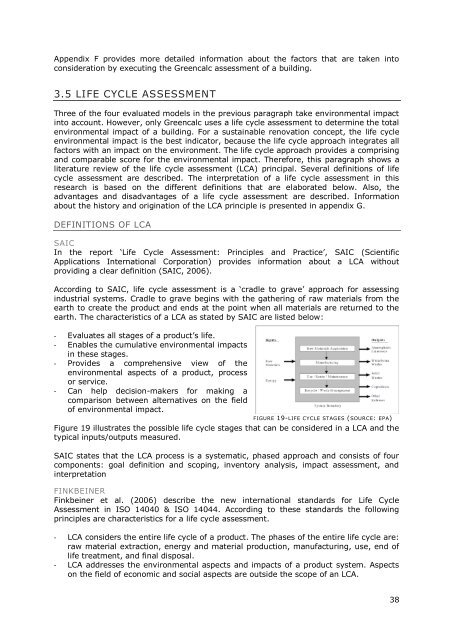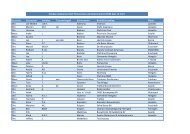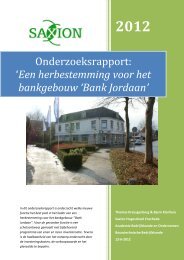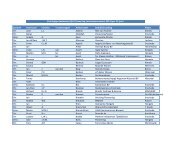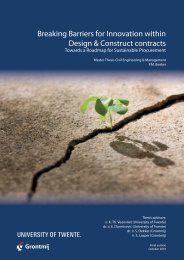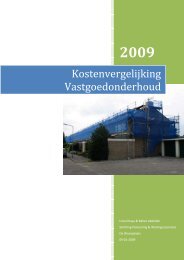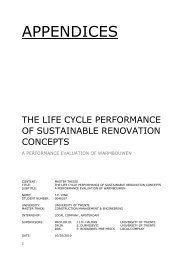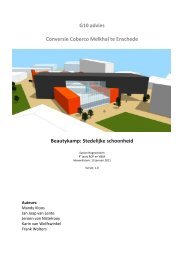the life cycle performance of sustainable renovation concepts
the life cycle performance of sustainable renovation concepts
the life cycle performance of sustainable renovation concepts
- No tags were found...
You also want an ePaper? Increase the reach of your titles
YUMPU automatically turns print PDFs into web optimized ePapers that Google loves.
Appendix F provides more detailed information about <strong>the</strong> factors that are taken intoconsideration by executing <strong>the</strong> Greencalc assessment <strong>of</strong> a building.3.5 LIFE CYCLE ASSESSMENTThree <strong>of</strong> <strong>the</strong> four evaluated models in <strong>the</strong> previous paragraph take environmental impactinto account. However, only Greencalc uses a <strong>life</strong> <strong>cycle</strong> assessment to determine <strong>the</strong> totalenvironmental impact <strong>of</strong> a building. For a <strong>sustainable</strong> <strong>renovation</strong> concept, <strong>the</strong> <strong>life</strong> <strong>cycle</strong>environmental impact is <strong>the</strong> best indicator, because <strong>the</strong> <strong>life</strong> <strong>cycle</strong> approach integrates allfactors with an impact on <strong>the</strong> environment. The <strong>life</strong> <strong>cycle</strong> approach provides a comprisingand comparable score for <strong>the</strong> environmental impact. Therefore, this paragraph shows aliterature review <strong>of</strong> <strong>the</strong> <strong>life</strong> <strong>cycle</strong> assessment (LCA) principal. Several definitions <strong>of</strong> <strong>life</strong><strong>cycle</strong> assessment are described. The interpretation <strong>of</strong> a <strong>life</strong> <strong>cycle</strong> assessment in thisresearch is based on <strong>the</strong> different definitions that are elaborated below. Also, <strong>the</strong>advantages and disadvantages <strong>of</strong> a <strong>life</strong> <strong>cycle</strong> assessment are described. Informationabout <strong>the</strong> history and origination <strong>of</strong> <strong>the</strong> LCA principle is presented in appendix G.DEFINITIONS OF LCASAICIn <strong>the</strong> report „Life Cycle Assessment: Principles and Practice‟, SAIC (ScientificApplications International Corporation) provides information about a LCA withoutproviding a clear definition (SAIC, 2006).According to SAIC, <strong>life</strong> <strong>cycle</strong> assessment is a „cradle to grave‟ approach for assessingindustrial systems. Cradle to grave begins with <strong>the</strong> ga<strong>the</strong>ring <strong>of</strong> raw materials from <strong>the</strong>earth to create <strong>the</strong> product and ends at <strong>the</strong> point when all materials are returned to <strong>the</strong>earth. The characteristics <strong>of</strong> a LCA as stated by SAIC are listed below:- Evaluates all stages <strong>of</strong> a product‟s <strong>life</strong>.- Enables <strong>the</strong> cumulative environmental impactsin <strong>the</strong>se stages.- Provides a comprehensive view <strong>of</strong> <strong>the</strong>environmental aspects <strong>of</strong> a product, processor service.- Can help decision-makers for making acomparison between alternatives on <strong>the</strong> field<strong>of</strong> environmental impact.FIGURE 19-LIFE CYCLE STAGES (SOURCE: EPA)Figure 19 illustrates <strong>the</strong> possible <strong>life</strong> <strong>cycle</strong> stages that can be considered in a LCA and <strong>the</strong>typical inputs/outputs measured.SAIC states that <strong>the</strong> LCA process is a systematic, phased approach and consists <strong>of</strong> fourcomponents: goal definition and scoping, inventory analysis, impact assessment, andinterpretationFINKBEINERFinkbeiner et al. (2006) describe <strong>the</strong> new international standards for Life CycleAssessment in ISO 14040 & ISO 14044. According to <strong>the</strong>se standards <strong>the</strong> followingprinciples are characteristics for a <strong>life</strong> <strong>cycle</strong> assessment.- LCA considers <strong>the</strong> entire <strong>life</strong> <strong>cycle</strong> <strong>of</strong> a product. The phases <strong>of</strong> <strong>the</strong> entire <strong>life</strong> <strong>cycle</strong> are:raw material extraction, energy and material production, manufacturing, use, end <strong>of</strong><strong>life</strong> treatment, and final disposal.- LCA addresses <strong>the</strong> environmental aspects and impacts <strong>of</strong> a product system. Aspectson <strong>the</strong> field <strong>of</strong> economic and social aspects are outside <strong>the</strong> scope <strong>of</strong> an LCA.38


